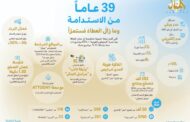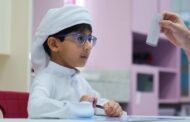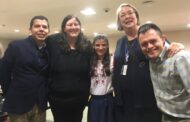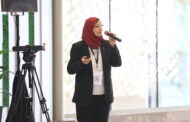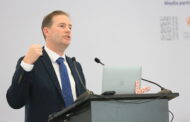Mr. Wael Ahmed Allam & Mr. Hicham Med Koutami
1. We would like to know you and some of your experiences.
I began my career in 1987 after finishing my education in both physical education and adapted physical education. In hindsight one of the reasons, I fell in love with adapted physical education was because it creates positive opportunities for sport and activity for those who may not have had past beneficial and social movement experiences. I related to this unconsciously because as a young female I was not allowed to participate in movement activities and sports. I was always a mover as a child and was happy to finally be able to participate in activity and sport in school and life.
I taught adapted physical education in the schools part-time for ten years and began teaching at Chico State University part-time in 1992. My doctorate was completed in 1999 and it was at that point that I became a full-time faculty member for Chico State University. My primary interest and research area was in adapted physical education focusing on Collaboration and Consultation in Adapted Physical Education.
2. Is it possible to talk about some of your scientific contributions, including books, studies, and research projects?
My primary research interests have been around the topics of inclusion and collaboration. My research, in written books, chapters, and articles include inclusive physical activity, programs for individuals with severe disabilities, autism, and general topics around adapted physical education in the schools. I have also focused on grants to support university students to train in adapted physical education.
https://www.csuchico.edu/kine/about/people/faculty/lytle-rebecca.shtml
3. Is this your first visit to Sharjah?
I have been fortunate to have visited Sharjah four times in the past. I first came to visit and learn about SCHS after meeting Sheikha Jameela Bint Mohammad Al-Qasimi when she visited Chico State University. She graciously invited us to bring university students to participate with the children and teachers at the Al Amal Camp hosted by SCHS. Since then, I have stopped in Sharjah a few times to either share information or visit. This past trip was the most significant. We brought 6 students (4 adapted physical education and 2 speech-language pathology students) and three faculty for two weeks. It was a wonderful opportunity to learn together and share ideas with the phenomenal physical education teachers and staff of SCHS. Every time we have brought university students to Sharjah, it has had a significant effect on them. They gain a great appreciation for the region, the people, the culture and our shared challenges as teachers and human beings.
4. What are your impressions of SCHS after your visits to its departments and branches and your meetings with its work teams?
I was very impressed with all the programs, facilities, and staff at every branch. It is clear that SCHS seeks to provide the most “state of the art” technology, equipment, and programs as well as evidence-based practices in all they do. As an adapted physical education specialist, I was especially impressed by the physical therapy, occupational therapy, and sensory rooms as these spaces are near and dear to my heart as a mover by nature. The facilities at SCHS are the best I have seen.
After touring the schools, we spent our time with the adapted physical education teachers. They we extremely gracious and friendly. They were open to sharing their work and welcomed us to their programs. The teachers were enthusiastic, motivated, and supportive of their students. SCHS has exceptional teachers and coaches. One of the wonderful aspects we observed was the way teachers dealt with behavior. In most cases there were no behavioral concerns, but when there was a distressed student, the teachers handled the situation with compassion, care, and support which are some of the most important aspects of teaching. It was clear that all the teachers care deeply for their students. We were also impressed with the teacher student ratios. In every class, learning was evident as students were on-task and engaged.
5. What do you recommend to new teachers in the field of adapted physical education?
My recommendations encompass four areas: Reach out to other professionals for ideas, stay open, join APE social media groups and professional organizations to learn new ideas and ask questions. Attend conferences and learn about what services and programs are available in one’s community, whether that is Special Olympics, recreational programs, horseback riding, aquatics, or other activities so they can be recommended to families beyond the school day. Lastly, enjoy the reflective and creative process as a life-long learner.
6. Are there recent trends or new practices in the field of adapted physical education that you can refer to?
After being in the field of adapted physical education for over 30 years, I see many of the same concerns repeat, such as the need to improve attitudes and perceptions toward the inclusion of individuals with disabilities. However, when the right supports are in place the process can be very successful. It is critical that students with disabilities truly feel like they belong, are a part of the school, and are respected and valued members of the community. Without this, it is not inclusion.
There are more and more evidence-based practices being identified for special education and many of these are applicable for the adapted physical education setting. In addition, physical activity is now included as an emerging evidence-based practice. This has been a positive outcome of research in special education related to the importance of movement for improved attention, stress reduction, and positive learning outcomes beside the known benefits of fitness.
https://ncaep.fpg.unc.edu/sites/ncaep.fpg.unc.edu/files/imce/documents/EBP%20Report%202020.pdf
Physical activity is beneficial for everyone for the same reasons. This is regardless of ability. It improves cognitive function, aids in stress reduction and relaxation, can provide for play and fun to enhance quality of life, as well as improving overall health and well-being for longevity.
7. How is the coordination between the adapted physical education specialist and the rest of the work team members?
The more professionals can collaborate to infuse each other’s goals and objectives into each teaching session, the more opportunities the student has for learning. For example, the adapted physical education teacher can infuse the language or academic goals into the physical education curriculum. it’s beneficial to use picture exchange communication system (PECS) or picture schedules consistent with a student’s communication goals, including colors, numbers, math concepts, or movement concepts to support the classroom goals. In addition, the speech pathologist might use movement as part of the speech lesson to support the adapted physical education goals. I feel that positive collaboration can greatly improve learning outcomes. It may not work with everything, but in many cases, services can support each other easily.
8. What are the common challenges between the UAE and the United States of America in the field of adapted physical education? And how can it be treated?
Teachers in both countries are looking for new ideas for activities to expand their curriculum and are interested in quality assessments and current teaching strategies. Attending conferences on adapted physical education and reaching out to other teachers to share ideas are good strategies. Also reading current research or practical journals for adapted physical education are helpful.
Teachers in both countries are working to create more opportunities for inclusion of students with disabilities in the schools with their peers. The more students in the schools are integrated the more the general population of students will be more accepting. We know from research that long term interaction with individuals with disabilities can have a positive influence on attitudes given the right role models and approach by teachers. The more students have opportunities to learn together, play together, and appreciate each other’s contributions, the more we see beyond any disability. We are all the same as human beings, with the need to feel appreciated, valued, respected, and a part, and to be able to contribute. Everyone has valuable skills that can contribute to the whole.









